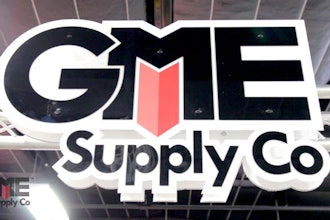BROUGHT
TO YOU BY:
FOR
DISTRIBUTORS,
DIGITALIZATION
DOESN’T
HAVE TO BE
ALL-OR-NOTHING
A LOOK AT
THE JOURNEY
TO DIGITALIZATION,
ITS BENEFITS
AND TOOLS
TO HELP
THE PROCESS
2 THE JOURNEY TO DIGITALIZATION: BENEFITS AND TOOLS TO HELP THE PROCESS
One would be hard-
pressed to find a distributor
executive who doesn’t
agree that the future of
their industry is digital.
Business-to-business
distributors have long been
behind the times when
it comes to technology
innovation and slow to
adopt it. Nonetheless,
distributors have gradually
been implementing or
upgrading software,
business tools and
hiring more tech-savvy
employees to increase
the digital element of
their culture. As a result,
both their customer-
facing operations and
back-end functions are
becoming more efficient.
3 THE JOURNEY TO DIGITALIZATION: BENEFITS AND TOOLS TO HELP THE PROCESS
Many leading distribution companies fully
embraced going digital years ago, and are
now in a great position to match or exceed
today’s rapidly changing business climate and
the buying habits of customers. Still, many
other distributors — especially those that
are small- to mid-sized or family-operated
for generations — are lagging behind and
are struggling to make the digital transition.
This disparity was evident in Industrial
Distribution’s 2017 Survey of Distributor
Operations, which polled 300 industrial
distribution employee respondents. Its survey
report showed the following respondent
statistics:
• Only 27% utilize enterprise resource
planning (ERP) software — which
was actually down 3 percentage
points from ID’s 2015 survey
• Only 53% utilize customer relationship
management software (CRM) —
down 3 points from 2015. The 53%
figure is surprisingly low considering
that respondents chose CRM as the
business technology that has the
greatest impact on their business.
• Only 20% utilize sales force
automation (SFA)
• 60% utilize online web ordering
• 14% said they are likely to adopt ERP over
the next 2 years — up 6 points from 2016
• 23% are likely to adopt CRM
over the next 2 years
• 20% are likely to adopt SFA
over the next two years
• 19% can’t recall how long it’s been
since their last website redesign
• 49% update their website content
less than once per month
• Only 33% have a mobile
app for their website
• Another noteworthy stat from ID’s
survey on the digital front is that 63%
of 2017 respondents said e-commerce
is a priority for them. While that figure
has ticked up over the years (58% in
2014; 60% in 2016), it shows that a
whopping 37% of respondents don’t
prioritize e-commerce. That’s despite
39% of respondents choosing online
web ordering as one of two digital
technologies that have the greatest
impact on their business. In June of
2017, market research firm Forrester
estimated that 2017 full-year B2B
e-commerce sales would be $889
billion, and that figure is expected to
reach $1.2 trillion by 2021. Despite
the rapid recent and expected
growth of e-commerce distributors
are still lagging behind overall.
THE STATE OF DISTRIBUTOR
DIGITALIZATION TODAY
even though they acknowledge its importance.
All these stats paint a picture of
a distributor landscape hesitant to embrace digitalization,
DIGITAL TOOLS USED
BY DISTRIBUTORS
71%
60%
53%
30%
Warehouse
management
systems (WMS)
Demand
forecasting
Customer
relationship
management
(CRM)
Sales force
automation
(SFA)
Online web
ordering
Customer
relationship
management
(CRM)
Wireless email/
internet access Online web
ordering
DIGITAL TOOLS DISTRIBUTORS
PLAN TO USE
33%
23%
20%
20%
Source: Industrial Distribution’s 2017 Survey of Distributor Operations
4 THE JOURNEY TO DIGITALIZATION: BENEFITS AND TOOLS TO HELP THE PROCESS
So why has digital adoption been so slow
amongst distributors? The first factor most
people want to point to is cost. And sure,
becoming a digital-first distributor has a price
tag. But the mistake many executives make
in this regard is looking at digitalization as
one massive, all-or-nothing project. Because
of this, digitalization appears too big, too
expensive, and too complicated to handle.
Digitizing every facet of your distribution
business from scratch surely would be
expensive. But adding even a single
digital element is better than none, and
the cost is substantially more affordable
when taking the approach of picking
individual business processes to digitize.
The bigger negative impact the ‘all-
or-nothing’ view creates is a culture of
resistance to digital. In an industry that still
has a large workforce portion comprised
of baby boomers, distribution employees
are often happy to be set in their ways.
“Executive buy-in is highly important —
it’s required,” says Mark Jensen, Director of
Product Management at Epicor Software.
“The companies I’ve talked with that are
doing it well — or at least continuing to
improve — are willing to make mistakes
and push forward despite some of the
complexities and hardships — and
executives are leading that charge.”
Another factor holding distributors
back is a lack of tech-savvy personnel.
Small companies and those with an older
workforce likely have limited employees
devoted to information technology, if any.
This can make the concept of integrating new
software and technology a daunting one.
Digitalization is much more manageable
when viewed instead as a process, with
step-by-step goals to accomplish along the
journey. Expecting your business to go from
primitive to suddenly having every digital tool
available is widely unrealistic for even the
largest of distributors, much less those that
have less than $10 million of annual revenue.
BARRIERS
TO ENTRY
Like any
business cultural shift,
digitalization
starts at the top.
5 THE JOURNEY TO DIGITALIZATION: BENEFITS AND TOOLS TO HELP THE PROCESS
DIGITALIZATION ELEMENTS
AND BENEFITS
GET HELP
The pros of prioritizing digital in your distribution business are many, and it can provide return
on investment in many forms.
Here are just some digital elements that can considerably improve your customer-facing
operations:
DIGITIZING YOUR SKU CATALOG:
Your 1,000-page print catalog may have been your bread-and-butter for
decades, but today’s buyers are shifting to a digital preference for product
viewing at an increasing rate. Even downloadable PDF catalogs are outdated
today. If you don’t offer e-commerce, having a digital catalog at least provides
a quick and easy way for your customers to view product information.
E-COMMERCE:
Its growth in B2B is undeniable, and even if your customers aren’t currently
asking for it, it’s only a matter of when. You might as well get ahead of the
curve. There are numerous e-commerce platform providers that can tailor
a platform for your business. A highly-responsive e-commerce offering
enables customer feedback and can help increase customer loyalty.
MOBILE APP:
Even some mobile-responsive websites are difficult to navigate on a smart
phone or tablet, and providing your customers with all the features of
your website on-the-go makes doing business with you even easier.
Many distributors like to keep everything
in-house when it comes to business
upgrades, but finding help is one of the
biggest keys to success in the digital journey.
And for those small and mid-sized companies
that don’t have the in-house resources to
implement individual digital solutions, finding
an outside partner may be their only option.
That’s certainly not a bad, thing, however,
as providers like Epicor have been helping
distributors choose, implement and support
the level of digitalization that is right for them.
“We really value the opportunity
to help with more than just providing
processes,” Jensen says. “We help them
look at their whole business and figure
out what needs to change to support
the growth they want to see.”
“It’s not that they couldn’t do this on their
own — it’s how much time and effort it
would take,” adds Tony Corley, Epicor Senior
Product Marketing Manager. “It’s something
where we have experts in almost anything
they’d need. They’ll save themselves a lot of
time and effort by utilizing us as a partner.”
6 THE JOURNEY TO DIGITALIZATION: BENEFITS AND TOOLS TO HELP THE PROCESS
Click here to
request a demo of
Epicor Prophet 21
today.
When it comes to the digital solutions
that can boost back-end operations and
employee efficiency, distributors should first
look to ERP. Depending on the provider, an
ERP system can include all the digital tools
a distributor could ever need and more.
An ERP system is now the backbone for
many distribution companies, consolidating,
and streamlining various operations
together and eliminates business silos.
As a premier ERP provider for distributors,
Epicor’s latest offering — Prophet 21 —
ties together order entry, financial
management, procurement, warehousing,
CRM e-commerce, inventory management,
performance management, and more into
a complete solution that is web-based
and extended to run on any browser.
This allows distributors to access the
software from any device, anywhere.
Enabling your employees to drive
information or dashboards to their cell
phone lets them take your business on-
the-go. Reducing the reliance on printing
out reports to get information cuts down
on office clutter and greatly speeds up
the information sharing process, while
metrics lead to smarter business decisions
instead of relying simply on intuition.
While ERP has become synonymous
with back-end operations, its features
also have customer-facing benefits.
By eliminating manual order entry
responsibilities, ERP frees up distribution
customer service representatives to do more
important and business growing tasks.
“Some of our customers’ service reps
were primarily entering orders — now
they’re looking to make those people
more like business analysts, helping
customers find a better deal,” Jensen
says. “The transaction isn’t the big deal,
it’s how we’re helping and analyzing that
customers’ purchasing patterns. Now they
can actually charge an additional 1 to 2
percent on an item because these services
are something that customers appreciate.”
In a market that is more competitive
than ever, distributors need any advantage
they can find, and ERP’s ability to enhance
customer relationships is a key differentiator.
“We always think of the benefits
distributors look for,” Corley adds. “We try to
help them increase sales, increase margins,
improving employee productivity, and set
themselves apart from competition.”
And because Prophet 21 users can pick
and choose the features they want, it
enables them to right-size their ERP and add
additional features as their business grows.
Maybe your business doesn’t need all the
bells and whistles ERP can offer, so it makes
more sense to buy only what you’ll use.
A CASE FOR ERP
7 THE JOURNEY TO DIGITALIZATION: BENEFITS AND TOOLS TO HELP THE PROCESS
This report was prepared by
Mike Hockett, Editorial Content
Director, Manufacturing Group,
Advantage Business Media, a
data-driven marketing solutions
company serving industry
professionals in the manufacturing,
science, and design engineering
markets. For more information,
visit advantagemedia.com.
Epicor Software Corporation
(epicor.com) provides complete
business digitalization along with
the refined distribution expertise
that comes from over 40 years
of experience in the distribution
industry — from open e-Commerce
platforms, to mobile sales and
services, to wireless sales counters
and warehouses, to advanced
inventory management, customer
optimization tools and direct 24x7
support. Epicor software is designed
so that your distribution business
can scale, adapt, and grow without
costly system modifications —
in the cloud, hosted, or on-premises.
ABOUT
THIS REPORT
ABOUT EPICOR
FOR DISTRIBUTORS, DIGITALIZATION DOESN’T HAVE TO BE ALL-OR-NOTHING
One would be hard-pressed to find a distributor executive who doesn’t agree that the future of their industry is digital. Nonetheless, distributors have gradually been implementing or upgrading software, business tools and hiring more tech-savvy employees. As a result, both their customer facing operations and back-end functions are becoming more efficient.
Latest in Home
Ferguson Reports Strong Results to Finish '25
September 16, 2025
Wesco Invests $10M in Procurement Software Startup
September 15, 2025
GME Supply Acquires Houston Workwear, PPE Supplier
September 12, 2025






















